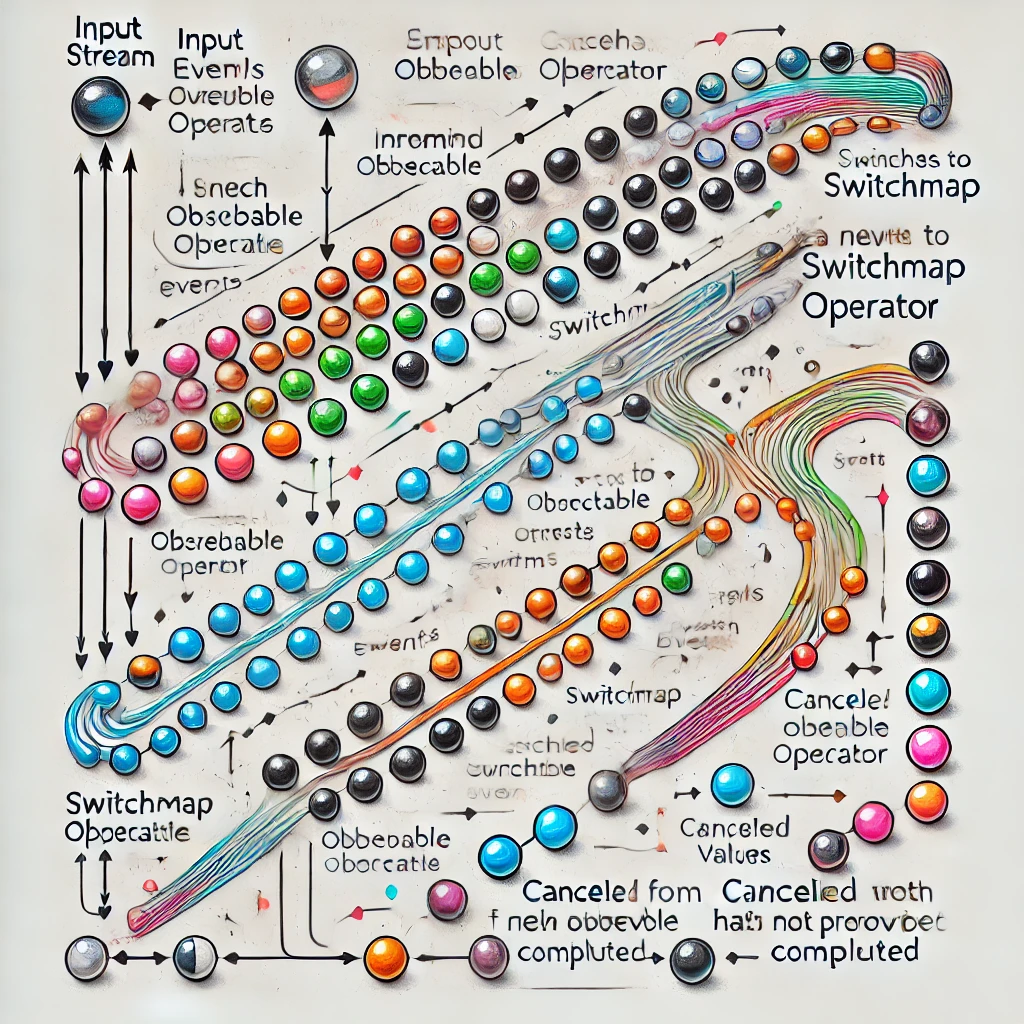Understanding RxJS
RxJS (Reactive Extensions for JavaScript) is a powerful library for reactive programming using Observables. It simplifies the process of composing asynchronous or callback-based code. RxJS provides a core type, the Observable, along with satellite types (Observer, Schedulers, Subjects) and operators inspired by Array methods (map, filter, reduce, every, etc.) to allow handling asynchronous events as collections.
One of the key strengths of RxJS is its ability to produce values using pure functions, making it easier to avoid complex stateful programs, using clean input/output functions over time. RxJS can be used for both client-side and server-side JavaScript applications, making it a versatile tool for managing data flows and events across different environments.
Key concepts:
- Observables: Represent a stream of data or events over time
- Operators: Functions that build new Observables based on the current Observable
- Subjects: Special types of Observables that allow values to be multicasted to many Observers
- Schedulers: Control the execution context and timing of subscription and delivery of notifications
These concepts work together to provide a robust framework for handling asynchronous operations, event-based programs, and complex data flows. By leveraging RxJS, developers can write more maintainable, less error-prone code, especially when dealing with real-time data or user interactions.
RxJS Explained
RxJS is built around the concept of Observables, which are lazy Push collections of multiple values. They can be thought of as streams that you can observe and react to over time.
Core building blocks:
Observable:
An Observable represents a stream of data that can be observed over time. It’s the foundation of RxJS and can emit multiple values, unlike Promises which resolve to a single value. Observables can represent various types of data sources, such as user inputs, API responses, or timer events. Example:
import { Observable } from 'rxjs';
const observable = new Observable(subscriber => {
subscriber.next(1);
subscriber.next(2);
subscriber.next(3);
setTimeout(() => {
subscriber.next(4);
subscriber.complete();
}, 1000);
});
Observer: An Observer is a consumer of values delivered by an Observable. It’s an object with three callback methods: next(), error(), and complete(). The Observer subscribes to an Observable to receive notifications. Example:
const observer = {
next: x => console.log('Observer got a next value: ' + x),
error: err => console.error('Observer got an error: ' + err),
complete: () => console.log('Observer got a complete notification'),
};
observable.subscribe(observer);
Subscription: A Subscription represents the execution of an Observable. It’s primarily useful for cancelling the execution. When you subscribe to an Observable, you get back a Subscription object that has an unsubscribe() method, which you can call to stop the ongoing execution. Example:
const subscription = observable.subscribe(x => console.log(x));
// Later, when you want to unsubscribe
subscription.unsubscribe();
Operators: Operators are pure functions that enable a functional programming style of dealing with collections with operations like map, filter, concat, reduce, etc. They take configuration options and return a function that takes a source Observable as input. When executing this returned function, it returns a new Observable, based on the source Observable, but modified according to the operator’s logic. Example:
import { of } from 'rxjs';
import { map, filter } from 'rxjs/operators';
const source = of(1, 2, 3, 4, 5);
const result = source.pipe(
filter(num => num % 2 === 0),
map(num => num * 10)
);
result.subscribe(x => console.log(x)); // Outputs: 20, 40
Subject: A Subject is a special type of Observable that allows values to be multicasted to many Observers. While plain Observables are unicast (each subscribed Observer owns an independent execution of the Observable), Subjects are multicast. Example:
import { Subject } from 'rxjs';
const subject = new Subject<number>();
subject.subscribe({
next: (v) => console.log(`observerA: ${v}`)
});
subject.subscribe({
next: (v) => console.log(`observerB: ${v}`)
});
subject.next(1);
subject.next(2);
Schedulers: A Scheduler controls when a subscription starts and when notifications are delivered. It consists of three components: a data structure to store and queue tasks, an execution context to execute tasks, and a clock to provide a notion of time. Example:
import { Observable, asyncScheduler } from 'rxjs';
import { observeOn } from 'rxjs/operators';
const observable = new Observable((observer) => {
observer.next(1);
observer.next(2);
observer.next(3);
observer.complete();
}).pipe(
observeOn(asyncScheduler)
);
console.log('just before subscribe');
observable.subscribe({
next(x) { console.log('got value ' + x); },
error(err) { console.error('something wrong occurred: ' + err); },
complete() { console.log('done'); }
});
console.log('just after subscribe');
These core building blocks work together to create powerful, flexible, and composable asynchronous operations. Understanding how they interact is key to mastering RxJS and reactive programming in JavaScript.
Common RxJS Operators Explained
switchMap
switchMap is used when you want to switch to a new Observable, canceling the previous inner Observable.
import { fromEvent, interval } from 'rxjs';
import { switchMap } from 'rxjs/operators';
const clicks = fromEvent(document, 'click');
const result = clicks.pipe(
switchMap(() => interval(1000))
);
result.subscribe(x => console.log(x));
mergeMap
mergeMap is used when you want to merge all inner Observables.
import { of } from 'rxjs';
import { mergeMap } from 'rxjs/operators';
const source = of(1, 2, 3);
const result = source.pipe(
mergeMap(x => of(x, x * 2, x * 3))
);
result.subscribe(x => console.log(x));
concatMap
import { of } from 'rxjs';
import { concatMap, delay } from 'rxjs/operators';
const source = of(1, 2, 3);
const result = source.pipe(
concatMap(x => of(`Result: ${x}`).pipe(delay(1000)))
);
result.subscribe(x => console.log(x));
map
map is used for simple transformations of each value emitted by the source Observable.
import { from } from 'rxjs';
import { map } from 'rxjs/operators';
const source = from([1, 2, 3, 4, 5]);
const result = source.pipe(
map(x => x * 10)
);
result.subscribe(x => console.log(x));
exhaustMap
exhaustMap ignores new inner Observables while the current inner Observable is still executing.
import { interval, fromEvent } from 'rxjs';
import { exhaustMap, take } from 'rxjs/operators';
const clicks = fromEvent(document, 'click');
const result = clicks.pipe(
exhaustMap(() => interval(1000).pipe(take(5)))
);
result.subscribe(x => console.log(x));
combineLatestAll
combineLatestAll combines the latest values from all inner Observables.
import { interval, take, map } from 'rxjs';
import { combineLatestAll } from 'rxjs/operators';
const source = interval(1000).pipe(take(2));
const result = source.pipe(
map(val => interval(1000).pipe(map(i => `Result (${val}): ${i}`), take(5))),
combineLatestAll()
);
result.subscribe(x => console.log(x));
concatAll
concatAll concatenates inner Observables in order, one after the other.
import { interval, take, map } from 'rxjs';
import { concatAll } from 'rxjs/operators';
const source = interval(2000).pipe(take(2));
const result = source.pipe(
map(val => interval(1000).pipe(map(i => `Result (${val}): ${i}`), take(5))),
concatAll()
);
result.subscribe(x => console.log(x));
concatWith
concatWith is used to concatenate multiple Observables.
import { concat, of } from 'rxjs';
import { delay } from 'rxjs/operators';
const source1 = of('Hello');
const source2 = of('World').pipe(delay(1000));
const source3 = of('Goodbye').pipe(delay(2000));
const result = concat(source1, source2, source3);
result.subscribe(x => console.log(x));
Conclusion
RxJS is a powerful library that can greatly simplify complex asynchronous operations in JavaScript. By understanding its core concepts and mastering its operators, you can write more efficient, readable, and maintainable code. Remember to always consider performance implications and use the appropriate operators for your specific use cases.
Further Reading and Useful Links
To deepen your understanding of RxJS and reactive programming, here are some valuable resources:
- Official Documentation:
- RxJS Official Documentation: The primary source for up-to-date information on RxJS.
- RxJS API Reference: Comprehensive documentation of RxJS operators and utilities.
- Learning Resources:
- Learn RxJS: A clear and concise reference for the most common RxJS operators.
- RxJS Marbles: Interactive diagrams of Rx Observables and transformations.
- Books:
- “Reactive Programming with RxJS 5” by Sergi Mansilla
- “RxJS in Action” by Paul P. Daniels and Luis Atencio
- Online Courses:
- RxJS: Getting Started on Pluralsight
- RxJS 6 In Practice on Udemy
- Community and Support:
- RxJS GitHub Repository: Source code and issue tracker
- RxJS Gitter Chat: Community chat for RxJS
- Advanced Topics:
- RxJS Subjects and Multicasting: Deep dive into RxJS Subjects
- RxJS Schedulers: Understanding the role of schedulers in RxJS
- Related Libraries and Frameworks:
- Redux-Observable: RxJS-based middleware for Redux
- NgRx: Reactive State for Angular applications
- Best Practices and Patterns:
- RxJS Best Practices: A collection of best practices for using RxJS in Angular applications
- RxJS Patterns: Common RxJS patterns and recipes
These resources cover a wide range of topics and skill levels, from beginner to advanced. Whether you’re just starting with RxJS or looking to deepen your expertise, these links provide valuable information and practical examples to enhance your understanding of reactive programming with RxJS.






